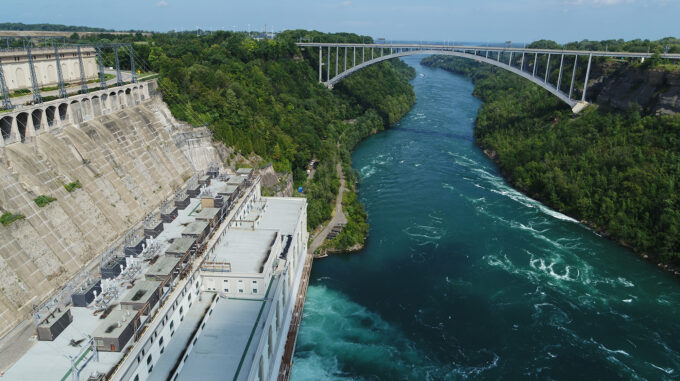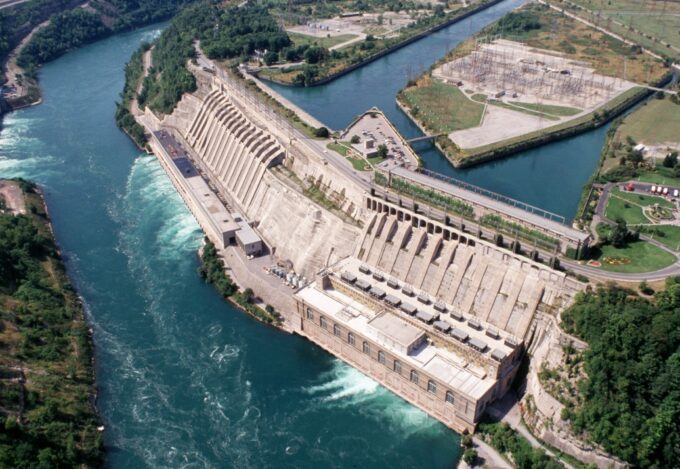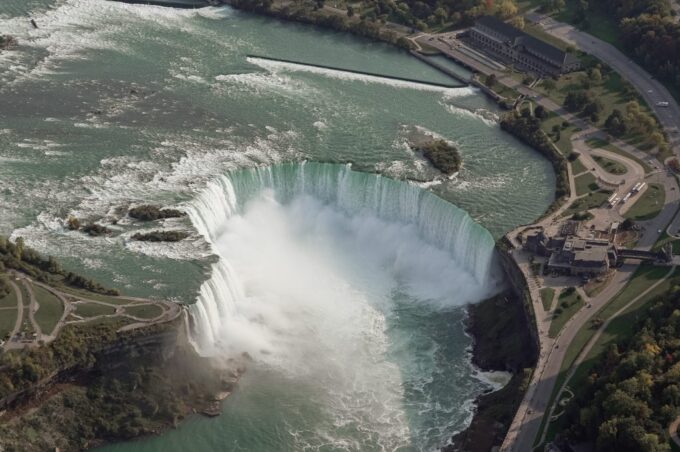
Source: opg.com
Niagara Falls has long been a symbol of natural power. Its roaring waters do more than attract millions of tourists annually. They drive one of the most impressive hydroelectric power systems in the world.
This article unpacks the complex systems behind its massive electricity output, exploring the processes that harness water into energy.
Key Points:
- Hydropower relies on the potential energy of falling water.
- Massive tunnels and conduits channel water to turbines.
- Turbines convert kinetic into mechanical energy.
- Generators transform mechanical energy into electricity.
- Energy distribution networks deliver power across regions.
The Natural Power Source
The sheer volume of water cascading over the falls is the core driver. The falls handle over 3,160 tons of water per second. The drop, combined with the water’s velocity, creates immense potential energy. The continuous flow ensures a consistent source of power, making Niagara Falls an ideal location for hydropower generation.
Water’s movement from the upper Niagara River to the lower river generates potential and kinetic energy. The height of the falls adds to the force of the water, maximizing power output. The geological structure, carved by glaciers thousands of years ago, plays a key role in maintaining the falls’ powerful flow.
This is such a natural phenomenon that visiting Niagara Falls reveals more than natural beauty. Tourists can learn about the history of hydropower, the evolution of technology, and the environmental measures in place.
Tours often showcase the engineering marvels behind power generation. For an in-depth experience, fallstour.com offers guided tours, including behind-the-scenes looks at hydroelectric facilities. Witnessing both natural and engineered wonders enriches the visitor experience.
The Role of Hydropower Stations

Source: power-eng.com
Hydropower stations convert water’s potential energy into electrical power. Two major facilities dominate: the Sir Adam Beck Power Station on the Canadian side and the Robert Moses Power Plant on the American side. Both stations employ similar principles but differ in infrastructure design.
These stations are engineering marvels, designed to maximize efficiency and sustainability. They operate continuously, adjusting water flow based on demand and environmental considerations. The infrastructure includes not just turbines and generators but also complex control systems that monitor performance and optimize power production.
How Water is Diverted
Instead of relying solely on the direct flow over the falls, engineers divert water through large tunnels. These conduits stretch for kilometers, guiding water from the Niagara River to the power plants. This diversion doesn’t diminish the falls’ beauty since strict regulations maintain minimum water flow for aesthetic and ecological purposes.
- Intake structures ─ Located upstream, these structures control water entry, ensuring a steady flow to the tunnels.
- Tunnels and penstocks ─ Tunnels lead to penstocks, massive pipes directing water to turbines. The design minimizes friction loss, preserving the water’s kinetic energy.
The diversion system is an intricate network of gates, channels, and reservoirs. Operators can adjust water flow in real-time, balancing power needs with environmental protection. This flexibility makes the system both powerful and adaptable.
The Mechanics Behind Energy Production
Water reaches turbines under high pressure. Turbines consist of blades that spin when hit by fast-moving water. This spinning motion generates mechanical energy. The process is highly efficient, with modern turbines converting over 90% of the water’s power into mechanical motion.
- Turbines ─ Convert kinetic energy from water into mechanical energy. The design of the blades maximizes efficiency by reducing turbulence.
- Generators ─ Attached to turbines, they convert mechanical energy into electrical power. Magnetic fields within the generators induce an electrical current, which is then transmitted to the grid.
The entire process is carefully monitored using advanced sensors and control systems. These technologies ensure optimal performance, reducing power loss and minimizing maintenance needs.
The Role of Gravity

Source: vacay.ca
Gravity pulls water down, creating kinetic energy. The higher the drop and the faster the water flows, the more power is produced. Niagara Falls’ unique geological formation makes it ideal for such conversion.
The natural gradient of the river enhances the water’s speed before it reaches the turbines. This acceleration increases the energy potential, allowing the power plants to generate more electricity with less water.
The Importance of the Grid
Once generators produce electricity, it’s transmitted to homes and industries. High-voltage transmission lines carry power over long distances with minimal loss. Transformers adjust voltage levels to suit different applications.
The grid is a complex network that balances supply and demand in real-time. Operators monitor energy flow, ensuring stability even during peak usage. Advanced software helps predict demand patterns, optimizing power distribution.
Sustainable Practices
Niagara Falls’ power plants prioritize sustainability. Water used for energy returns to the river, maintaining the ecosystem. Additionally, strict environmental regulations ensure minimal ecological disruption.
Efforts include fish-friendly turbines, habitat restoration projects, and continuous monitoring of water quality. The goal is to produce clean energy without compromising the natural environment.
Technological Innovations Over Time
View this post on Instagram
Since the first power plant in 1895, advancements have improved efficiency. Modern turbines are more effective, and automation optimizes water flow management. Continuous upgrades ensure maximum output with minimal environmental impact.
Innovations include:
- Advanced turbine designs ─ Reducing energy loss and increasing durability.
- Smart grids ─ Enhancing energy distribution efficiency.
- Real-time monitoring systems ─ Allowing quick response to operational changes.
These improvements reflect a commitment to both technological excellence and environmental stewardship.
Why Niagara Falls Remains a Powerhouse
The combination of vast water volume, significant drop height, and advanced engineering keeps Niagara Falls a leading source of hydroelectric power. Ongoing investments in infrastructure and technology guarantee its role in sustainable energy production for generations to come.
The strategic location, abundant natural resources, and continuous innovation ensure that the falls remain at the forefront of renewable energy. The collaboration between engineers, environmentalists, and policymakers supports a balanced approach to energy production.
The Historical Journey of Hydropower at Niagara Falls
The history of hydropower at Niagara Falls dates back over a century. The first power plants were revolutionary, showcasing the potential of renewable energy. Pioneers like Nikola Tesla and George Westinghouse played crucial roles in developing alternating current (AC) systems, making long-distance power transmission possible.
Early facilities used simple turbines and basic generators. Over time, improvements in materials, engineering techniques, and control systems transformed hydropower into a sophisticated industry. Today, Niagara Falls stands as a testament to human ingenuity and the enduring power of natural resources.
Fun Facts About Niagara Falls’ Energy Production
- Power output ─ The combined power plants generate over 4.9 million kilowatts of electricity.
- Environmental focus ─ Over 75% of the water diverted for energy returns to the river, maintaining ecological balance.
- Global impact ─ Niagara Falls supplies energy to both the United States and Canada, supporting industries, homes, and public services.
Conclusion
Niagara Falls’ isn’t just a scenic wonder. It’s a testament to human ingenuity, transforming raw natural forces into reliable energy. The blend of natural power and engineered precision showcases the potential of sustainable resources in meeting global energy demands. As technology evolves, Niagara Falls will continue to inspire and power the world, bridging the gap between nature and human achievement.



